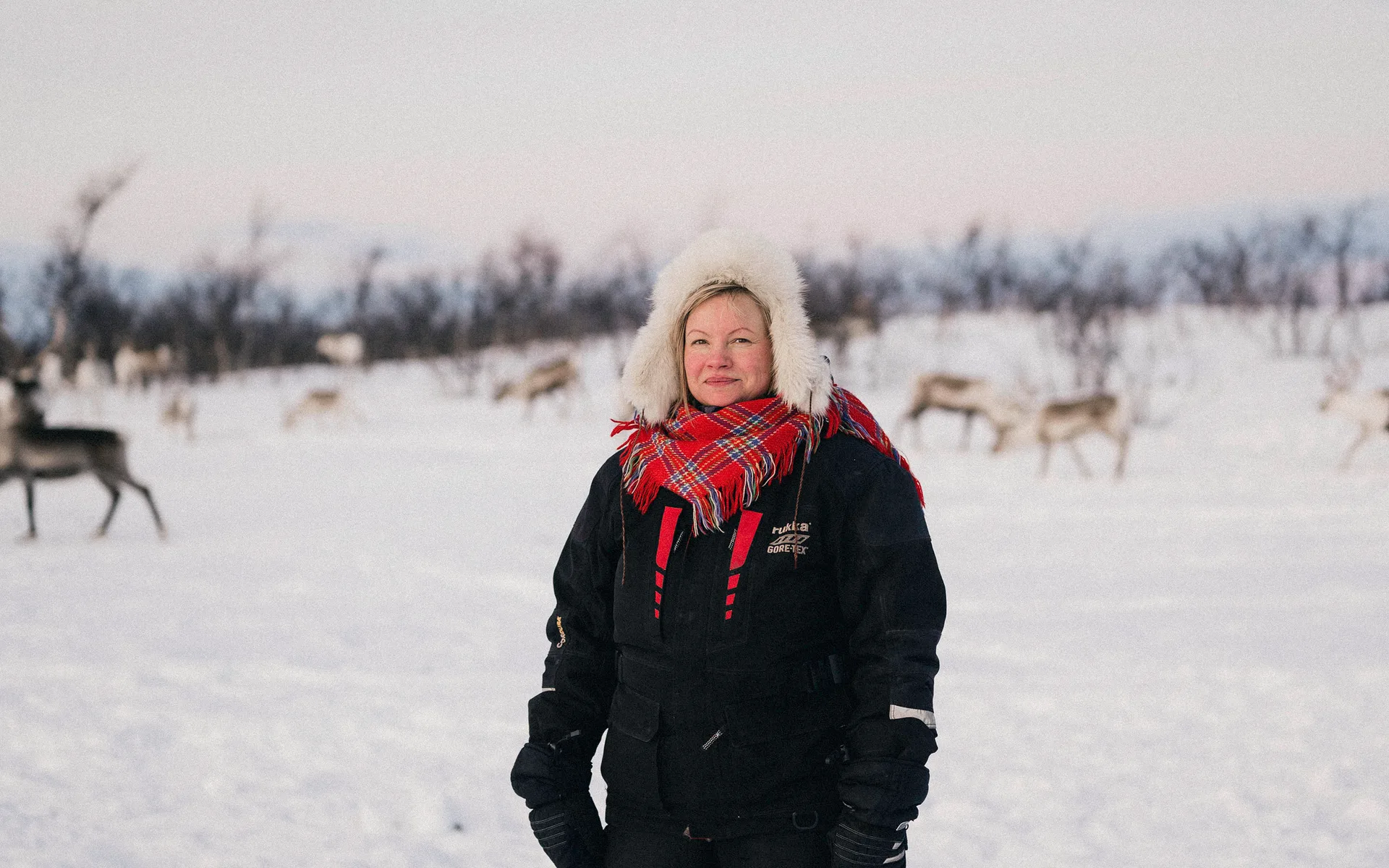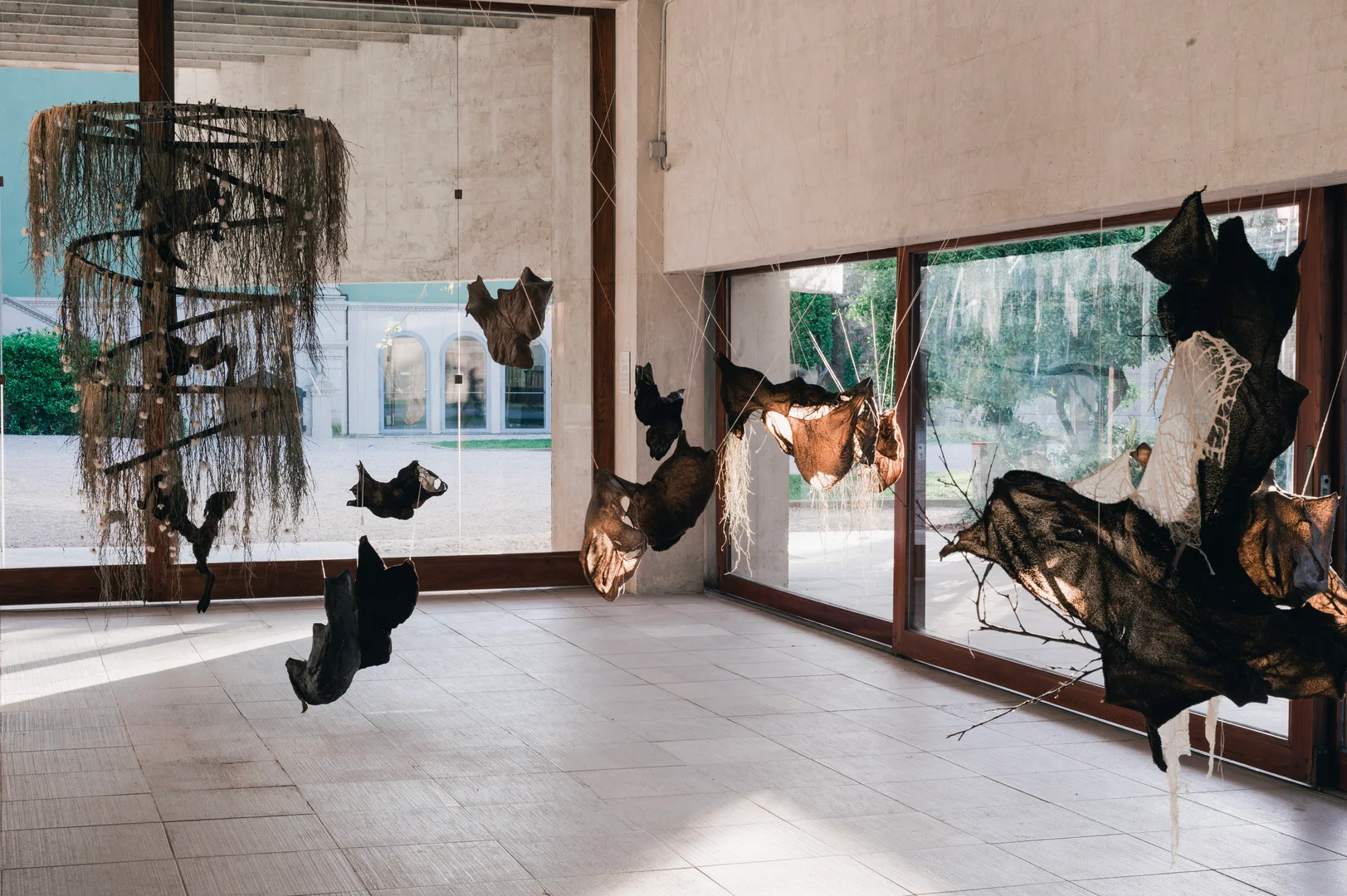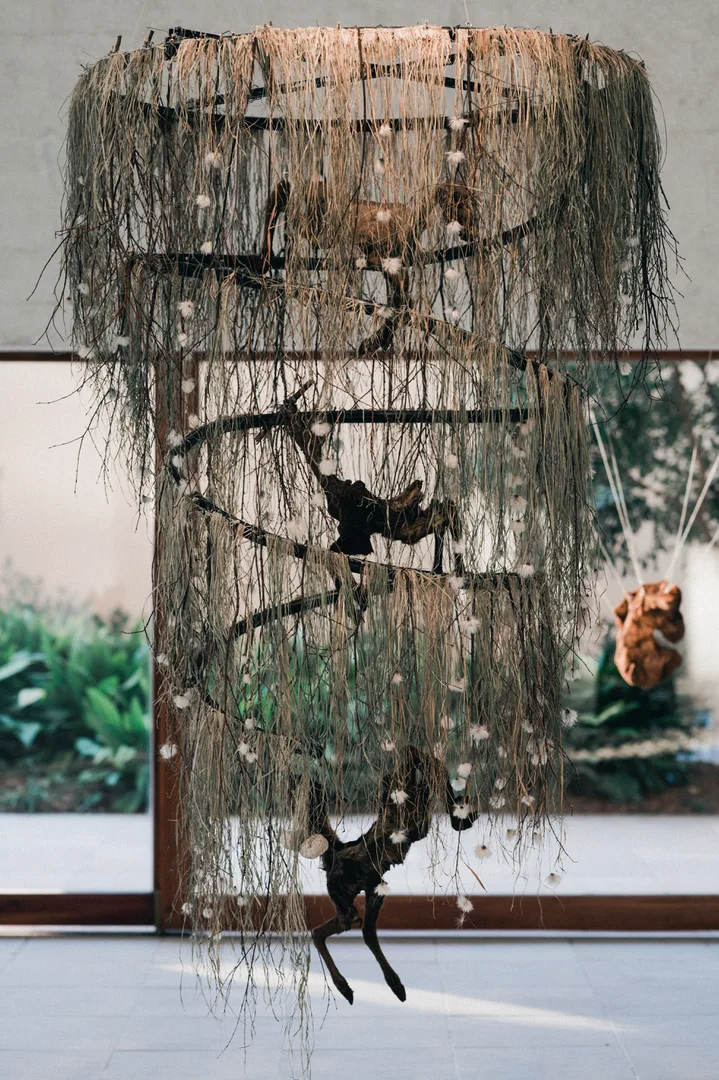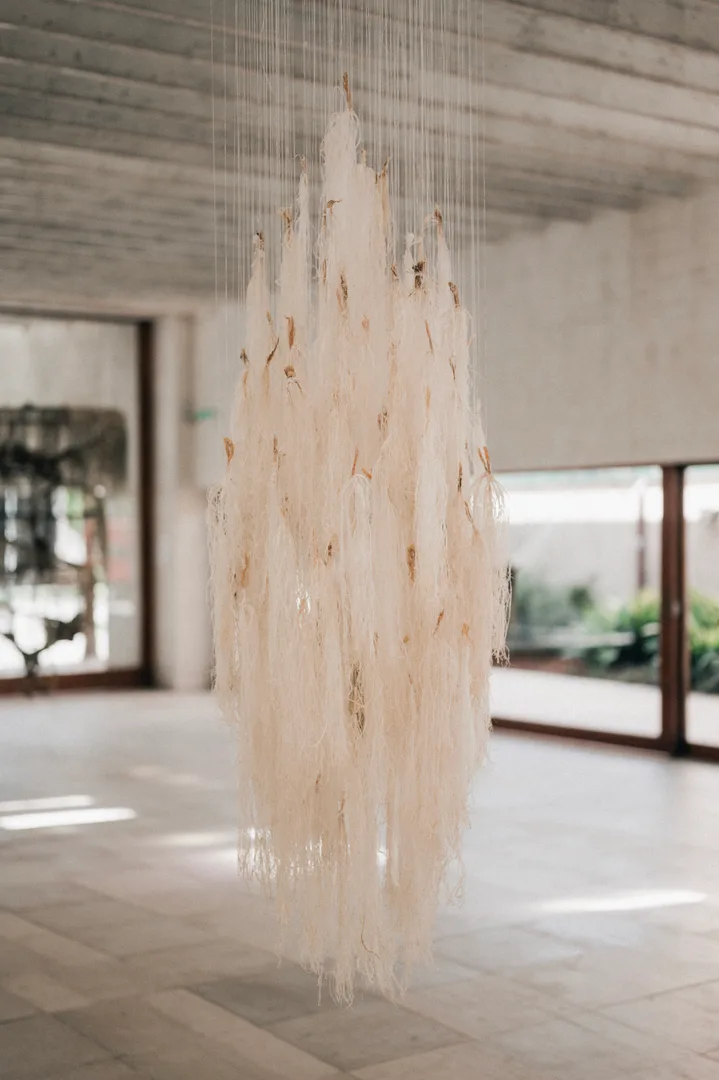
Máret Ánne Sara
Gutted – Gávogálši (2022)
Reindeer stomachs
Ale suova sielu sáiget (2022)
Cured red reindeer calves, cotton grass, birch branches, gámasuoidni (shoegrass)
Du-ššan-ahttanu-ššan (2022)
Reindeer sinews, wax, molecular compositions: fear (reindeer under stress, reindeer stools, diesel motors), hope (maternal breast milk, reindeer milk, newborns, tundra)
Smells created in collaboration with Nadjib Achaibou and Oswaldo Maciá.
Sámi Elder: Fimben Áillo Gáren / Káren E. M. Siri Utsi

Foreground: Máret Ánne Sara, Gutted – Gávogálši, (2022). Background: Máret Ánne Sara 'Ale suova sielu sáiget' (2022). Installation view 'The Sámi Pavilion'. Photo: Michael Miller / OCA

Máret Ánne Sara, Ale suova sielu sáiget, (2022). Installation view 'The Sámi Pavilion'. Photo: Michael Miller / OCA

Máret Ánne Sara, Du-ššan-ahttanu-ššan, (2022). Installation view 'The Sámi Pavilion'. Photo: Michael Miller / OCA
After the long and hard struggle our family has been through against the Norwegian state to protect our reindeer from forced slaughtering, I have a strong need to seek and manifest faith and hope. I tell my stories through the reindeer because what happens to the reindeer also happens to us. From an Indigenous perspective, I don’t see humans as superior or central. As human beings on this earth, we are simply a part of an interconnection of life forms and the constant dialogue and interdependence between these. My work asks questions about what happens when outside powers enforce laws upon you that systematically force you to break your own and collective ethics and morals, epistemology and philosophy. When your sanity is criminalised, how do you counter and continue?
—Máret Ánne Sara
Based in Guovdageaidnu, in the Norwegian side of Sápmi, Sara comes from a tundra reindeer herding family. The three works presented in the pavilion were conceived in the aftermath of a seven-year legal battle with the Norwegian state to defend the herding rights of her younger brother, one of the many court cases experienced by young Sámi reindeer herders today. Sara’s focus on the reindeer as the cornerstone of Sámi life is intended to heal and repair the inflicted trauma. The works were made following Sámi ethics and methods of sustainable resource use, finding value in reindeer parts not used for food and clothing; the animals presented died a natural death.
Gutted – Gávogálši is a constellation of dried reindeer stomachs addressing Sámi spiritual and material forms of knowledge and kinship. The work highlights the stomach as a first site of emotion to events in the world and underlines their sensate power as a parallel intelligence that connects humans, reindeers and other life. This gamus dovdat and čoalit dovdet, which translates as ‘we know by instinct’ and ‘gut feeling’, is highly valued by Sámi philosophy. Each stomach represents a person responsible for the conflicts recently experienced by the Sara family; in so doing, the artist redirects the trauma back onto the perpetrators, cleansing herself and her family from it.
Ale suova sielu sáiget is a rotating sculpture composed of cured calves and dried plants from the tundra, conceived as a carrousel of death and birth, fear and joy, trauma and hope. It was created whilst the artist was carrying her first-born and considered the future of Sámi youth in a colonially unbalanced world. Through the work the artist grieves the loss of the red newborn calves to state-imposed pressures (such as the effect of environmental laws over protecting alpha predators) as well as to starvation resulting from the growing impact of climate change; she rejoices in each calf born as the carrier of new life, as a continuation of the herd and of the Sámi people.
Du-ššan-ahttanu-ššan consists of two suspended, cloud-like forms of reindeer sinews, imbued with smell, as an elementary part of the non-verbal communication that happens between lifeforms and their surroundings. The smell in one of the forms conjures the ongoing stress and fear experienced by humans and reindeers during colonising processes; and in the other, the hope needed to resist and generate a new future.
Biografi
Máret Ánne Sara (f. 1983) er en nordsamisk kunstner og forfatter fra Guovdageaidnu/ Kautokeino i den norske delen av Sápmi. Sara er en av grunnleggerne av kunstnerkollektivet Dáiddadállu i Guovdageaidnu/Kautokeino og er en del av en ny generasjon samiske kunstnere som arbeider for å beholde og forbedre samiske rettigheter. Hun er kjent for å eksperimentere med forskjellige materialer, tilnærminger og kollektive kunsthandlinger, og hennes praksis synliggjør politiske og sosiale utfordringer som påvirker det samiske folket, spesielt reindriftssamfunn, med et kritisk blikk på den pågående kolonialismen. Hennes skulpturer og installasjoner er ofte lagd av materialer fra den bærevennlige praksisen til hennes reindriftsfamilie, ved å behandle beina, skinnet og innvollene til reinsdyrene på den sedvanlige måten og omforme dem til moderne kunstverk.
Sara er mest kjent for verket Pile o’Sápmi, en installasjon bestående av 400 reinsdyrskaller og juridiske dokumenter, vist på documenta14 i Kassel 2017. Installasjonen ble nylig kjøpt av Nasjonalmuseet. Pile o’Sápmi er også tittelen på et pågående kunstprosjekt og protestbevegelse som involverer andre samiske kunstnere i solidaritet med Saras bror Jovsset Ánte Sara i hans kamp mot den norske stat i retten.
Tittelen på dette prosjektet refererer til Pile o' Bones, den engelske oversettelsen av Plains Cree-navnet for Regina, Canada (Oskana ka-asastēki) og viser også til bildene av millioner av bøffelhoder som hvite nybyggere slaktet for å sulte urbefolkningen i Nord-Amerika. Pile o’Sápmi har hatt mange forskjellige former, som installasjoner med reinsdyrskaller og som smykker lagd fra reinsdyrporselen (som henviser til benporselen, noe britene fant opp for å etterligne porselen ved å bruke bøffelbein som råmateriale). Etter hvert som brorens rettssak fortsatte i de forskjellige rettsinstansene installerte Sara forskjellige versjoner av Pile o’Sápmi foran Deatnu/Tana tinghus, Romsa/Tromsø lagmannsrett og foran Stortinget i Oslo mens saken pågikk i Høyesterett.
De forskjellige versjonene har også vært utstilt på Tenthaus, Dronning Sonja KunstStall, Kunstnerforbundet og Nuuk Art Museum på Kalaallit Nunaat/Grønland. Pile o’Sápmi Power Necklace ble vist på utstillingen 'Let the River Flow. The Sovereign Will and the Making of a New Wordliness' kuratert og produsert av OCA i 2018. Sara deltar for øyeblikket i utstillingen 'Environmental Injustice – Indigenous Peoples’ Alternatives' ved Musée d’ethnographie de Genève, Sveits, med et nytt verk og en serie av tidligere verk.
Etter at hun studerte illustrasjon ved Arts University Bournemouth, Storbritannia, har kunstneren også jobbet i stor grad med collager og trykk som viser raseri og sinne mot statens misbruk av samiske symboler og identitetsmarkører. Sara har også jobbet som journalist og redaktør av det samiske ungdomsmagasinet Š, og har utgitt to romaner, Ilmmiid gaskkas (Mellom verdener), 2013 og Doaresbealde doali, (Utenfor sporet) 2014. Hun ble nominert til Nordisk Råds barne- og ungdomslitteraturpris i 2014 for Ilmmiid gaskkas, debutromanen hennes, som ble utgitt på nordsamisk, norsk og engelsk.